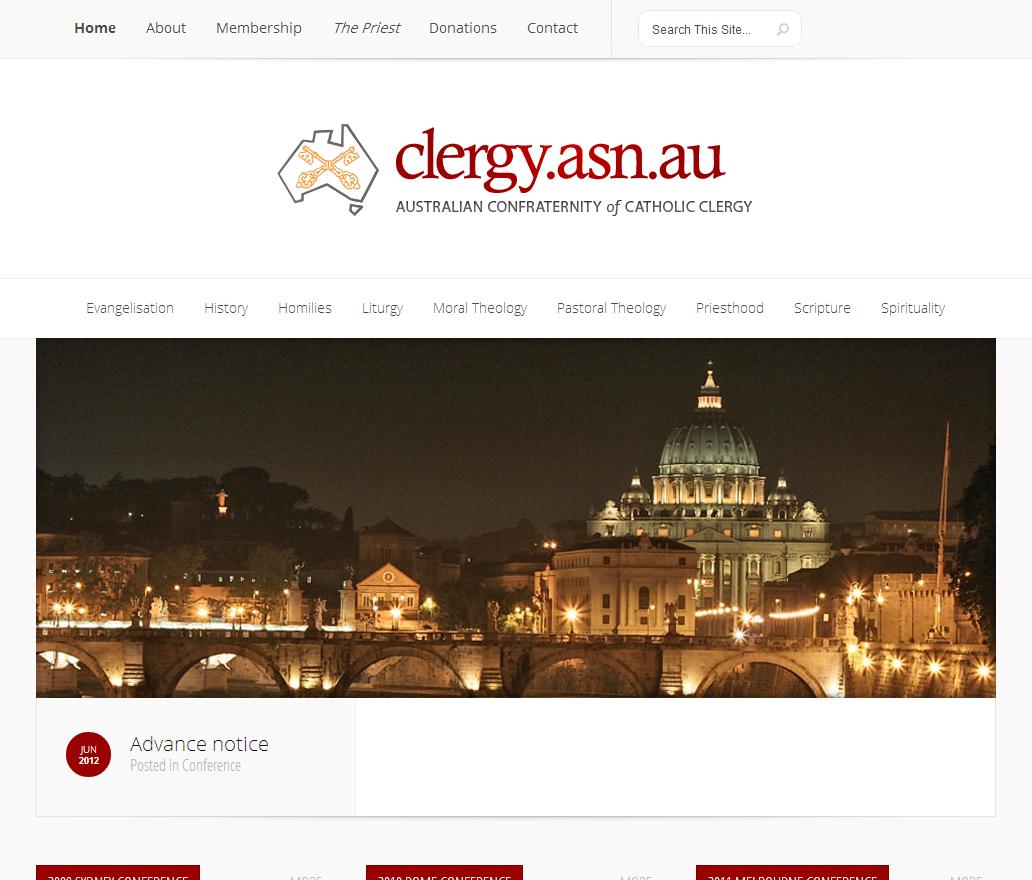St Paul’s Publications have published an international version of the New Community Bible, which during the Year of Faith is available for only $11. This is a real bargain, especially considering it has a hardback cover and a thumb index. I’ve ordered my copy already.
The NCB is a reworking of the Christian Community Bible, which the Filopino Claretian Fathers published in 1988. The CCB, in turn, originated from a Spanish translation, the Biblia Latinoaméricana, which was produced by a French Claretian in Chile. Wikipedia gives the history.
Apart from its price, the NCB claims to have in its favour an easy-to-read style and lengthy footnotes which are not only scholarly, but also catechetical and homiletical. If I had to compare it to one of the better known translations, the Jerusalem Bible comes to mind. The readings at Mass are based on the Jerusalem translation, and I often use the New Jerusalem for spiritual reading and prayer.
Different translations and editions are good for different purposes. At the seminary, we were required to use the Revised Standard Version or the New Revised Standard Version for study purposes, since these translations are more precise. I favoured the Ignatius Bible, which is the best edition currently available of the Revised Standard Version — Catholic Edition. I like the language of the RSV. The scriptural quotes I have memorised are typically in this translation. The NRSV is okay, but I think it lacks the RSV’s poetry.
I have also bought several volumes of the Ignatius Catholic Study Bible. These are inexpensive books — paperback, stapled, and printed on cheap paper — which are ideal for scripture study. I could highlight text and scribble notes in the margins without troubling my conscience. (I don’t like defacing books!) Scott Hahn’s lengthy footnotes were a great complement to the lecturers’ remarks.
I like the Navarre Bible for homiletical purposes. It uses the NRSV translation, but what sets it apart are the extensive footnotes which quote from the Church Fathers and many modern saints — especially St Josemaría Escrivá, who founded Opus Dei, which in turn founded the University of Navarre from which the Navarre Bible gets its name.
And, just because I like the author, and the idea of his translation, I also treasure my Knox Bible. It’s something of a tragedy that Msgr Knox was obliged to translate the Latin Vulgate, rather than translate the Hebrew and Greek originals. The restrictive terms set by the English bishops means that his translation — a monumental effort by one man! — became obsolete much sooner than it should have.
I’d like to think the New Community Bible is a valuable addition to my scriptural library. At $11 it’s worth a try, anyway. Here’s the publisher’s press release.






Dear Father Corrigan,
A good post. Incidentally people can donate to St Pauls to send copies of the NC Bible to places such as PNG and various African countries.
Besides the various editions that you mention, which I have and use for different purposes, there are others that may be of interest. There is the Westminster Version of the NT, produced under the editorship of Father Lattey SJ between 1913 and 1936, though it is difficult to get hold of. A second useful source is the Bible by Hawthorn Publishing of the USA (1958). The OT is Douay-Reims, except for the Psalms, which are Westminster Version. The NT is the Westminster Version, without the extensive essays of the original. The Hawthorn Bible has an introduction by Pope Pius XII recommending it to English-speaking readers.
In Christo,
Anthony Bidgood
It might be wise not to encourage too much diversity in biblical translations, especially in the use of those like the JB and (by your description) the NCB which are translations of translations rather than from the original Greek and Hebrew (the only exception that I will make to that rule is a translation based on the Vulgate – but then it is a translation of the Vulgate, not of the Greek and Hebrew Scriptures). We will soon be “happy, always happy in the Lord” (to use the JB mangalation of Phil 4:4) to kiss goodbye to the Jerusalem Bible lectionary and receive the lectionary based upon the English Standard Version (Oxford Edition). It will be a great relief, now that we have the Latin Mass in English, to also have the Greek and Hebrew Scriptures in the same fine English language.
You raise an interesting question David. Is the New Community Bible a translation of a Spanish translation, or a translation of the Greek and Hebrew? Until now, I had assumed it was the latter, but now I’m doubtful.
Does anyone know the answer to this?
(PS I’m glad you give the Knox a pass David! Ha ha.)
India’s controversial St. Pauls’ New Community Bible now sold in Australia
http://ephesians511blog.wordpress.com/2013/03/07/indias-controversial-st-pauls-new-community-bible-now-sold-in-australia/
” Msgr Knox was obliged to translate the Latin Vulgate, rather than translate the Hebrew and Greek originals. The restrictive terms set by the English bishops means that his translation — a monumental effort by one man! — became obsolete much sooner than it should have.”
Dear father, How can a very modern English translation of the Vulgate, which for over 1500 years defined Catholic faith and produced its saints and doctors of the Church, has all of a sudden — became “obsolete”?
Msgr Knox’ translation and style is far more readable than modern translations, which are but gnostic archeology, nothing more.
Fair question ZMWT. I do not wish to give the impression that the Vulgate is irrelevant. On the contrary! It remains the only “official” translation of the Hebrew and Greek texts; a translation which is itself recognised as inspired.
Sadly, though, no translation-of-a-translation can make such a claim. A translation-of-a-translation is always disadvantaged when compared to a direct translation. Knox’s style is superior, and his translation would be superior too, if it was direct.
Re-reading this post three years on, I wonder why I have neglected the Douay-Rheims. This is another valued English translation, and especially interesting to compare with Knox.
In analysing Vulgate, Church found problems; there were variations among copies spread throughout Christendom. That means that during the centuries, and before the invention of printing press, copyists made slips, errors, own changes and/or enhancements (to what they believed is better Latin). We may never know how the exact translation of St Jerome’s looked like. Therefore we have a standardised Vulgate, called Clementine, made from best copies.
I found Douay-Rheims strange translation; I cannot dismiss the impression that the committee who made it loved Latin, and barely tolerated English, for which they must have held is but a lesser language.
Knox version starts from Vulgate, and indeed, wherever Latin renders no clear or dubious sense (which may be due to copyist errors), Msgr Knox adds alternative meaning from Greek or Hebrew in the footnotes. Footnotes in the Knox Bible are a remarkable and honest addition, but even in cases where they are added, I also see Latin in such cases was indeed inspired; Latin translator penetrated the metaphor in an remarkable way.
That, I think, modern translations will never achieve for they were not blessed in their attempt. They couldn’t be, because the Bible Catholics already have, is one approved, and is sufficient.
The Knox Bible is a happy marriage of great love for tradition, and remarkable proficiency in English; he finds phrases, rhythm and beauty in English Douay-Rheims translation sometimes simply refuses to acknowledge. One simple example:
— (Douay-Rheims) And the king of Egypt spoke to the midwives of the Hebrews: of whom one was called Sephora, the other Phua, Commanding them: When you shall do the office of midwives to the Hebrew women, and the time of delivery is come: if it be a man child, kill it: if a woman, keep it alive. → Exodus 1:15-16
— (Knox Version) Then the king of Egypt gave orders to Sephora and Phua, the midwives who attended the Hebrews; When you are called in, he said, to attend the Hebrew women, and their time comes, kill the child if it is a boy; if it is a girl keep it alive. → Exodus 1:15-16
Douay-Rheims translation is full of English words, but the phrases, the rhythm, and the sentences seldom read as English. A “man child”? Douay-Rheims translators nor the editor could not find a better word for Latin “masculus fuerit” than — a “man child”? Or an oddity like this,
(Douay-Rheims) After he was dead, and all his brethren, and all that generation, the children of Israel increased, and sprung up into multitudes … – Exodus 1:6
“After he was dead’? Odd phrasing, flow so interrupted that by the end of the paragraph we barely remember its beginning. Compare to it much better, and buttery smooth translation by Msgr Knox,
(Knox Version) When he and his brethren and all their next descendants were dead, the race of Israel grew into a teeming multitude … – Exodus 1:6
It seems as if translators from Douay and Rheims and Msgr Ronald Knox spoke two different languages.